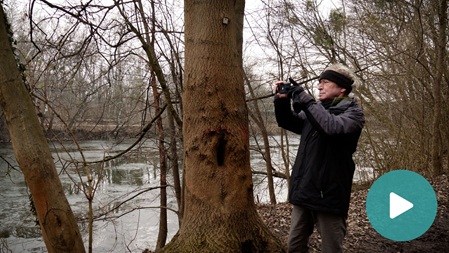Eberhard Jordan: When I arrived this morning, I actually thought to myself, "Now I'd really like to have breakfast first." But there wasn't enough time. Otherwise, I was actually glad it didn't rain.
Hermann Krammer: The Donauturm, as Austria's tallest building, is of course a perfect place to draw attention to the illness with this campaign. We are very proud that Mr. Jordan was able to create such a stir with this health campaign, both nationwide in Austria and worldwide.
Johannes Aiginger: For Chiesi, it's important that we support such campaigns because we know that therapeutic, meaning exercise therapy and medicinal therapy, must go hand in hand. For the company and the Chiesi family, research into medicinal therapies has always been a priority. But we know that patients' motivation simply has an enormous influence on the effectiveness of therapy. In that regard, we are very happy that we were able to support him again this year.
Sophie Meingassner: We were already involved last year, and we see a great future here for the coming years as well. It's important to show that one's own decision and one's own taking responsibility for health has such a great impact; whether that's simply through physical training, or by quitting smoking or becoming smoke-free and staying smoke-free, because that is so fundamentally relevant for the prevention and non-worsening of COPD.
Andreas Budz: For us, Mr. Jordan is truly a wonderful example that we can also use as a role model or an incentive for all the other patients we care for. It's not about having to climb the Donauturm, but it's really about the individual patient, who is often socially isolated and withdrawn due to their illness, gaining a little courage. And Mr. Jordan is actually the best example we could find for us in that regard.
Dr. Milos Petrovic: In terms of speed, saturation, and heart rate, it went optimally.
Mag. Susanne Ergott-Badawi: The Austrian Chamber of Pharmacists is very happy to support this campaign and congratulates Mr. Jordan on this great initiative. Through our daily consultations in the pharmacy, we also contribute to ensuring that COPD patients are treated correctly and well. We advise on the correct use of inhalers. It is important here that the medicine gets to where it belongs, namely into the lungs.
Eberhard Jordan: We found a very good rhythm, both walking rhythm and breathing rhythm, and at some point, you just meditate your way up the stairs, and then you arrive.
Felix Wallner: This morning, on my way here, I paid attention to whether I would hear anything about World COPD Day on the radio, and I heard nothing. That's why I was then positively surprised that so many TV stations were there, and especially that there was a lot of press here. That really positively surprised me and also encouraged me that if we participate here and support this, then we are a part of it, and then we can also give back a little of the wonderful work Mr. Jordan is doing here.
Eberhard Jordan: I have the feeling the media interest was very good. Otherwise, I have to say, I simply think it was a nice event.
Martin Gütlbauer: It was a different kind of challenge. Just being there caused a certain tension – media and flashlights, etc. I couldn't even hear Eberhard anymore, what his exact breathing rhythm was behind me. That was my challenge today.
Niklas de Mare: We are thrilled that he was successful again this year on the Donauturm. I believe that's double the height compared to St. Stephen's Cathedral last year. We also supported him last time. We support his idea because we believe that the way he promotes the topic to the target group is much more sustainable than all doctor's appointments, for example, and we hope that he sets a new, much higher goal for next year, and we are convinced that he will achieve it.
Dr. Milos Petrovic: To achieve this performance with this lung function, this lung capacity of 28%, is something that should also be an incentive for other patients: that you shouldn't give up, but continue to train and take your medication, then miracles are also possible. And this miracle also happened today with Mr. Eberhard Jordan; he made it.
Eberhard Jordan: So, my personal goals for next year regarding COPD are certainly to become active again. There are still towers in Austria that have more steps, one could consider that. Or one could consider international perspectives; I'll leave that open.











